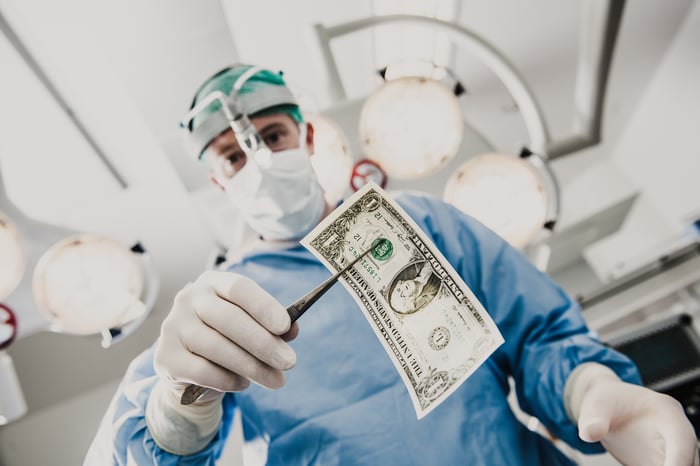The healthcare space should offer investors one of the most robust growth opportunities in the years and decades to come. It allows investors to take stakes in the companies behind potentially lifesaving drugs and devices.
At the center of it all is healthcare conglomerate Johnson & Johnson (JNJ 0.05%).

Image source: Getty Images.
Johnson & Johnson is the unquestioned leader in the healthcare space
There are more than 1,100 healthcare stocks listed on the major U.S. exchanges, according to Finviz, but none stands taller than Johnson & Johnson, which sports a $438 billion market cap.
Most folks are likely unaware, but J&J is one of only two publicly traded companies left that sports the highly coveted AAA credit rating from Standard & Poor's. That's actually a higher rating than the agency has assigned to the U.S. government. In other words, S&P has more confidence that Johnson & Johnson will repay its debts over time than it has of the U.S. government making good on its own debts.
But a superb credit rating isn't the only reason J&J is a popular holding in the investment community and the largest healthcare stock in the United States. Its success is based on its three operating segments each bringing something important to the table. For example, consumer healthcare products is a slow-growing segment, but it provides exceptional pricing power and highly predictable cash flow. Meanwhile, medical devices are growing slowly for now, but the operating division is perfectly set up to take advantage of an aging U.S. and global population. Lastly, J&J's pharmaceuticals segment generates the bulk of its operating margin and growth. However, brand-name drugs have only a finite period of sales exclusivity.
The combination of these factors helped Johnson & Johnson to grow its adjusted operating earnings for an almost unfathomable 36 consecutive years.
These healthcare stocks could be bigger than J&J by 2035
But if there's one constant when it comes to investing, it's that few things are ever constant. It's common for the list of the world's largest companies to shuffle extensively over time. Looking out to 2035, there are three healthcare stocks that have the potential to unseat Johnson & Johnson as the largest healthcare stock by market cap.

Image source: Getty Images.
The logical choice: UnitedHealth Group
If another healthcare stock is going to leapfrog J&J in size, the obvious choice is UnitedHealth Group (UNH 1.46%). With a market cap of $383 billion, it's already within striking distance. I'd also mention that, over the trailing decade, J&J's shares are up 150%, whereas UnitedHealth has soared 740%. If this outperformance keeps up, the changing of the guard could happen well before 2035.
UnitedHealth Group has two very important operating segments. Most people are probably familiar with the company's health insurance offerings. Health-benefit providers are often able to produce predictable cash flow, and they rarely struggle to pass along higher premiums, when necessary. With President Joe Biden looking to rebuild the Affordable Care Act, which was signed into law by former President Barack Obama, UnitedHealth's opportunity to add new members is growing.
But it's not the insurance segment that would be responsible for pushing UnitedHealth over the top. Rather, it's Optum, which is a pharmacy-benefits manager and care services company. Optum itself is broken down into three core segments:
- OptumRx provides pharmacy care/prescription filling services;
- OptumInsight offers data analytics, consulting and research to hospitals, health plans, and other health-centric organizations; and
- OptumHealth provides care through local medical groups and ambulatory care systems.
Optum is growing considerably faster than UnitedHealth's traditional insurance services, and its margins are better, too. It'll be the key to whether or not UnitedHealth surpasses Johnson & Johnson.

Image source: Getty Images.
If things go just right: Intuitive Surgical
Another healthcare stock with an opportunity to surpass J&J in market cap, but that would need a lot to go right, is robotic-assisted surgical systems developer Intuitive Surgical (ISRG -1.93%). Intuitive Surgical has a current market cap of $97 billion.
Intuitive is probably best-known for developing the da Vinci surgical system. This system is installed in hospitals and surgical centers worldwide and is used for a variety of soft tissue procedures. The idea behind robotic-assisted surgery is that it'll be more precise than laparoscopic surgery, leading to fewer complications and a quicker recovery time, which health-benefit providers should love.
Since the beginning of the century, Intuitive Surgical has installed more than 6,100 of its da Vinci systems around the world, most of which are located in the United States. This may not sound like a lot, but it's far and away more than all of its competitors on a combined basis. It offers a variety of price points, as well as lease options, which have made its systems accessible to developed and emerging markets.
What's really special about Intuitive Surgical is that it's built to expand its margins over time. In its early years, selling its pricey da Vinci system made up the bulk of its revenue. Unfortunately, these are intricate and costly systems to build, which led to only mediocre margins. Today, the company is generating most of its revenue from the sale of instruments and accessories with each procedure, along with the servicing off its systems. Thus, the bigger the installed base of da Vinci systems, the more revenue skews to these higher-margin segments.
If things go just right and Intuitive Surgical maintains its utter dominance of the robotic-assisted surgical space, it could oust Johnson & Johnson as healthcare top stock by or before 2035.

Image source: Getty Images.
The long shot: Teladoc Health
If you want a true long shot to surpass J&J, look no further than telehealth giant Teladoc Health (TDOC -4.64%). It only has a $24 billion market cap at the moment, but 14 years is a lot of time for the considerably faster-growing and innovative Teladoc to leapfrog Johnson & Johnson.
As you can rightly imagine, Teladoc was a big-time winner of the coronavirus pandemic. Doctors did everything in their power to keep high-risk and potentially infected patients from heading to hospitals or their offices. That meant turning to telemedicine like never before. Teladoc handled almost 10.6 million virtual visits in 2020, which was up from 4.14 million in the previous year.
But keep in mind that this isn't just a pandemic play. Teladoc had grown its sales by an annual average of around 75% in the six years leading up to the pandemic. The reason? Telehealth offers improved outcomes up and down the treatment chain. It's more convenient for patients to stay home, and it can allow physicians to better keep tabs on their most chronically ill patients. Meanwhile, health insurers benefit from the lower billed cost of virtual visits, relative to office visits, and the prospect of improved patient outcomes.
In addition to being the telehealth kingpin, Teladoc acquired leading applied health signals company Livongo Health in the fourth quarter. Livongo collects mountains of data of chronically ill patients and with the help of artificial intelligence sends its members tips to help them lead healthier lives. It was profitable on a recurring basis and regularly doubling its sales when acquired by Teladoc.
If we witness telehealth consolidation and the steady embrace of technology in the healthcare space, Teladoc has a chance, albeit small, of bypassing Johnson & Johnson's market cap by 2035.





